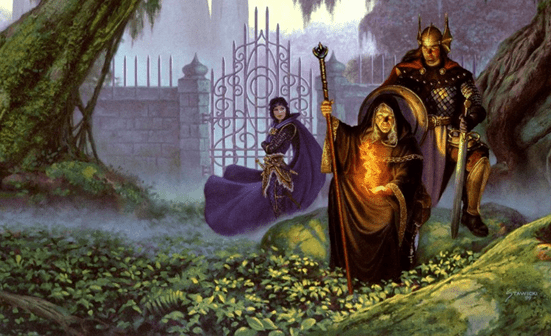 One of the most enduring stories about the origins of the Dragonlance novels is that the books were written from the events taken directly from gaming sessions and our play.
One of the most enduring stories about the origins of the Dragonlance novels is that the books were written from the events taken directly from gaming sessions and our play.
The truth is … a bit more complicated than that.
Dragonlance was originally envisioned as a series of role-playing modules for the Advanced Dungeons & Dragons role-playing game. This was before ‘Second Edition’ was even considered. So initially the primary direction of the design was toward creating adventure modules that were linked in theme, world and continuing story. Novels were, at least initially, considered to be only a ‘secondary product’ at best; something extra that we could do which might make a few additional dollars out of the brand.
It isn’t surprising, therefore, that so much of our early efforts went into the games and making as fine a set of adventure modules as possible. Doing that meant not only writing those games but testing them as well.
From my first working at the company, it had been established that Thursday afternoon was ‘play-test’. This meant that none of the design staff was permitted to continue with their regular work assignments but were tasked to play games throughout the afternoon. If one of our game designs was sufficiently far down its development path, then we would play those games and try to ‘break them’ — meaning find the flaws in the rules which could be exploited unfairly or which made the game not functional. We would also determine if the game was fun to play or if it just dragged. Sometimes we would be assigned to play games from other game companies to take them apart, see what worked and what did not and use that experience in creating our own games. Down the years I’ve enjoyed telling people outside the company that I was forced to play games every Thursday afternoon as part of my job and it was perfectly true: analyzing and breaking games was something that we all became quite good at doing and no game is ever perfect the first time. And our enthusiasm for games was such that we often scheduled these tests outside of work.
So when the first of the Dragonlance modules needed to be tested, I put together an AD&D game in our little two bedroom apartment on the second floor in Lake Geneva. We were living one floor down from Jeff and Kate Grubb and a floor up from Tim and Heidi Kilpin, fellow workers at TSR, Inc. I believe Jeff and Kate came to that playtest session that evening. My wife took a part while occasionally tending to our then two children. Douglas Niles — another designer and great contributor to Dragonlance was there as Flint — and Margaret Weis also attended. As fate would have it, Terry Phillips, a friend whom we had known in our Utah days, was also working for the company then and, bringing his theater background with him, join us that night and took the part of Raistlin.
As the game progressed that night with me as the Dungeon Master, two things happened which the astute and observant Margaret Weis picked up on during play:
The first was Terry Phillip’s portrayal of Raistlin. Whenever Terry spoke ‘in character’ as Raistlin, he did so in a raspy, whispering voice. It was menacing and not just a little creepy to hear but what Margaret observed was that whenever Terry spoke in that voice, the rest of the room went silent in order to hear what he had to say. Margaret realized not only was this a quality that would have come from Raistlin’s background but it was also a manipulative technique of getting everyone’ attention and having them pay careful attention to him when he spoke. This, Margaret realized, was something which Raistlin would pick up on and use for his own gain. From Terry’s voice characterization that night, the essence of Raistlin drew life’s breath.
The second was an incidental character which suddenly sprang to life. As a Dungeon Master for the game, I was intrigued with my friend Terry’s portrayal of Raistlin and decided to give him a character to play against. So it was that Bupuh the Gully Dwarf sprang out of my imagination during the game. Raistlin’s ‘charm’ spell worked far too well and their relationship was born. Margaret noticed the juxtaposition of this innocent and somewhat repellent character with the world-wise cynicism of Raistlin, the contrast of which defined even more clearly Raistlin in turn.
While many have assumed that Margaret simply ‘wrote down’ what happened during our games and that when we had written down enough game sessions had clued it together into a book is far from the truth. Game sessions do not make good stories; their structure is different and a discussion of that will be left for another time.
What is true, however, is that the portrayal of these two characters in the game surprised Margaret and I by inspiring us about who those characters really were or needed to be in the books, and therefore shaped the story that followed in fundamental and important ways.

2 replies on “Dragonlance: The Story and the Game”
I’d love to be able to interview the elusive and shadowy Terry Phillips! He only worked for TSR for a short while, but created one of the most enduring wizards in all of Dungeons and Dragons! Whatever happened to him?!
This was a very interesting read for old-time Dragonlance fans such as myself! Thanks!!